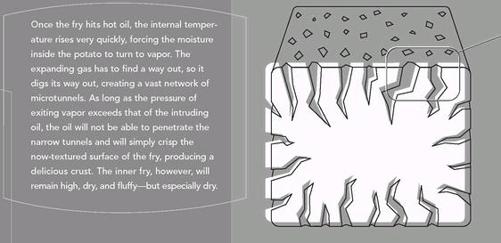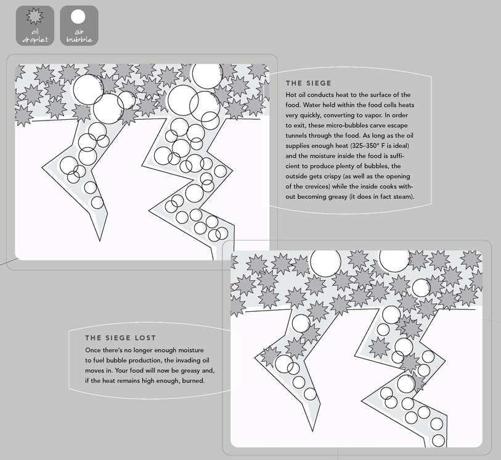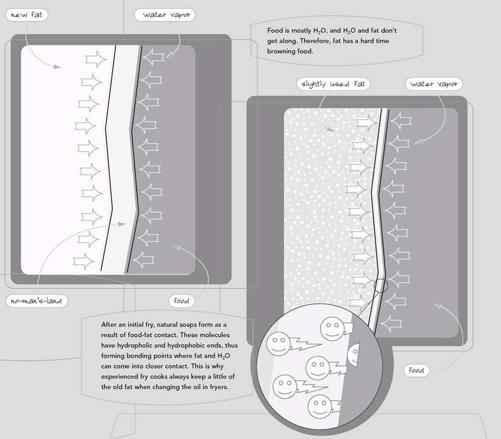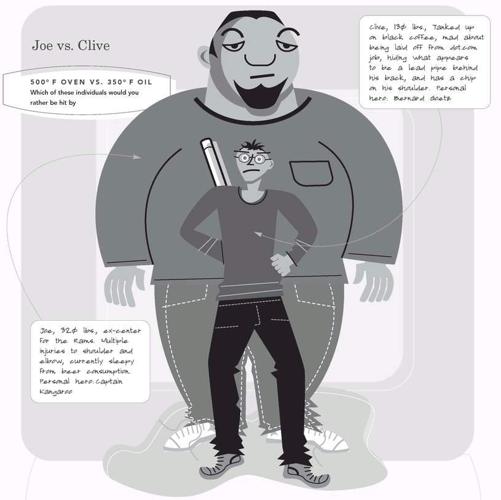I'm Just Here for the Food (18 page)
Read I'm Just Here for the Food Online
Authors: Alton Brown
Tags: #General, #Courses & Dishes, #Cooking, #Cookery

Immersion-frying is like a siege. The hot oil surrounds the food and looks for ways in. The water at the surface of the food defends its home by turning to vapor and pushing out in all directions (why most foods seem to boil furiously at the beginning of the process), which is a good reason not to over-fill the vessel.
As the water vapor exits the food, it is replaced by moisture moving up from the food’s interior. The same thing happens to the moisture in a baking potato, which explains why the center of a properly cooked french fry tastes pretty much like a baked potato.
Fried food cooks so fast that it’s actually tough to determine whether it does so via conduction or internal steam; at the very least it’s a combination of the two.
Anatomy of a French Fry
SECRETS TO MAKING GREAT FRIES
1.
Start with high-starch potatoes (like russets) for fries that are crunchy on the outside and fluffy on the inside.
2.
Cut potatoes in uniform pieces with a V-slicer for even cooking.
3.
Soak cut potatoes in water to get rid of the excess starch on their surface. This will prevent the fries from turning dark and enable the moisture to escape via steam so that the fries aren’t gummy.
4.
Fry twice. This is essential for great fries. During the first fry (at a lower temperature of 300° F), fries will go floppy and turn pale gold. During the second fry (at a higher temperature of 350° F), they’ll crisp and darken a little. Result: crispy golden outside and tender inside.
5.
Now you’ve got great fries, but you’re not done yet. Fried foods have to drain properly or they’ll become greasy. Don’t use paper towels or brown paper bags; they’ll just hold the grease right up against the food. Use a draining rig instead (see
illustration
).
6.
Last but not least, season fries while they’re hot. Why? Because salt and pepper will stick to the thin film of hot oil that remains on the surface. If you wait too long, this oil will either drip off or soak in and your seasoning will have nothing to hold on to.



Why New Fat Doesn’t Brown Well

Making Oil Last

A lot of respected cooking authorities will tell you that you should use oil once, then toss it. Fine, but where? You can’t pour it in that ditch behind the house, and pouring it down the drain would do a lot of damage to your pipes. The EPA suggests saving it, along with bacon drippings and the like, in a resealable can, which you can tape up and throw away when it gets full. Great: so every time I deep fry I’ve got to find a quart can, and seal it, and store it like so much toxic waste. If I followed this line I would never fry again. Luckily, most great fry cooks agree that oil can be reused several times, as long as it’s cleaned and stored properly and cut with new oil each time it’s used.
After I deep-fry, I let the oil cool down to a manageable temperature then filter it through the oil rig pictured here. A strainer catches the big pieces, while the cheesecloth between the strainer and the funnel works as a fine filter (If the oil is still warm, a cone-shaped coffee filter can be used.) I use a clean green wine bottle because, like red wine, oil doesn’t like light. The tall, narrow shape of the wine bottle helps keep most of the oil away from the other thing it doesn’t like: air. After the filtering, I add new oil up to a line, marked by a heavy rubber band, which tells me I’ve got enough to reach the “fill” line on the fryer. I cork the bottle tightly and store it away from the light. This doesn’t mean I never get rid of the oil—it won’t last forever—but if I start out with peanut or safflower oil, I find I get five or six sessions out of it, depending of course on the target food.
When it is time to ditch, I’ve still got a challenge because I don’t generally have many coffee cans around. I do have some pretty stout freezer bags, though, which I hold on to after they seem to have picked up a few too many fragrances for my liking. So I put the bag inside an empty paint can, fill it up, seal it (here comes the nerdy part), and use my cigar lighter to barely melt the edge, thus sealing it forever. I then seal this in yet another bag and after that the dog doesn’t even try to get into it—you could drop it on the sidewalk and nothing would happen.
FIRE!
The majority of home fires start—you guessed it—in the kitchen. Prevention, of course, is the best medicine, so keep recipe books, dishtowels, and the like away from heat sources, and be prepared if you do see flames. Don’t automatically think bucket brigade. A grease fire needs to be starved of air; dousing it with water will make it worse. Small fires can be smothered using the lid to a pot or a couple of handfuls of baking soda. If that fails, reach for your trusty fire extinguisher. Yes, you should have a fire extinguisher nearby. There are three classes of fire extinguishers. Class A are for standard combustibles, paper, fabric, and wood, but should never be used on burning liquids or electrical fires. Class B are for flammable liquids, while class C don’t conduct electricity and are the choice for “live” electrical fires. Every kitchen should have a BC-class or ABC-class extinguisher.
Why is frying in 350° F oil so fast and furious compared to cooking in a 500° F oven? Remember, from my rambling diatribe on conduction, that temperature is only one piece of the heat equation, just as voltage is only one part of an electrical equation.
Consider:
• Joe weighs more than some cattle and pummels people for a living.
• Clive weighs less than a heavy wind and punches a keyboard for a living, or at least he used to.
• Based solely on this information one might determine that Joe has more potential to do damage to you if he were to hit you.
But there are other factors to consider:
• Joe has been hit in the head many, many times. He is easily distracted by things like puppies, which he likes to pet. In other words, his ability to deliver on all that physical potential is limited.
• Clive, on the other hand, has years of rage stored in his wiry frame. He just got laid off, blames the world for his persistent acne, and is carrying a piece of lead pipe.
• Joe is a 500° F oven. Clive is 350° F oil.

PANKO
Also referred to by some as Japanese-style bread crumbs, these have a coarser texture than ordinary bread crumbs and make for a great crunchy crust. The tan-colored crumbs are made from a whole loaf of bread, while the white ones result from using the bread without the crust. If you can’t find them on your local grocery’s shelves, check upscale stores or Asian markets. Suitable substitutes for panko include regular bread crumbs or cracker meal.
BREADING, DREDGES, AND BATTERS, OH MY
Fried foods are unique in that they usually have some kind of starchy coating. This coat, which Brillat-Savarin referred to as the “surprise,” can be as simple as a dusting of flour or as complex as a multilayered breading.
The purposes of such a coating are to:
• Create a great tasting crust that intensifies and highlights the flavor of the food.
• Protect the food from the thermal maelstrom of the hot oil.
How does the crust happen? Once the food hits the oil, the escaping moisture gets together with the oil and the starch to create a kind of gel, which hardens as it cooks.
